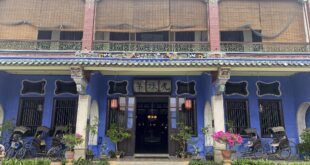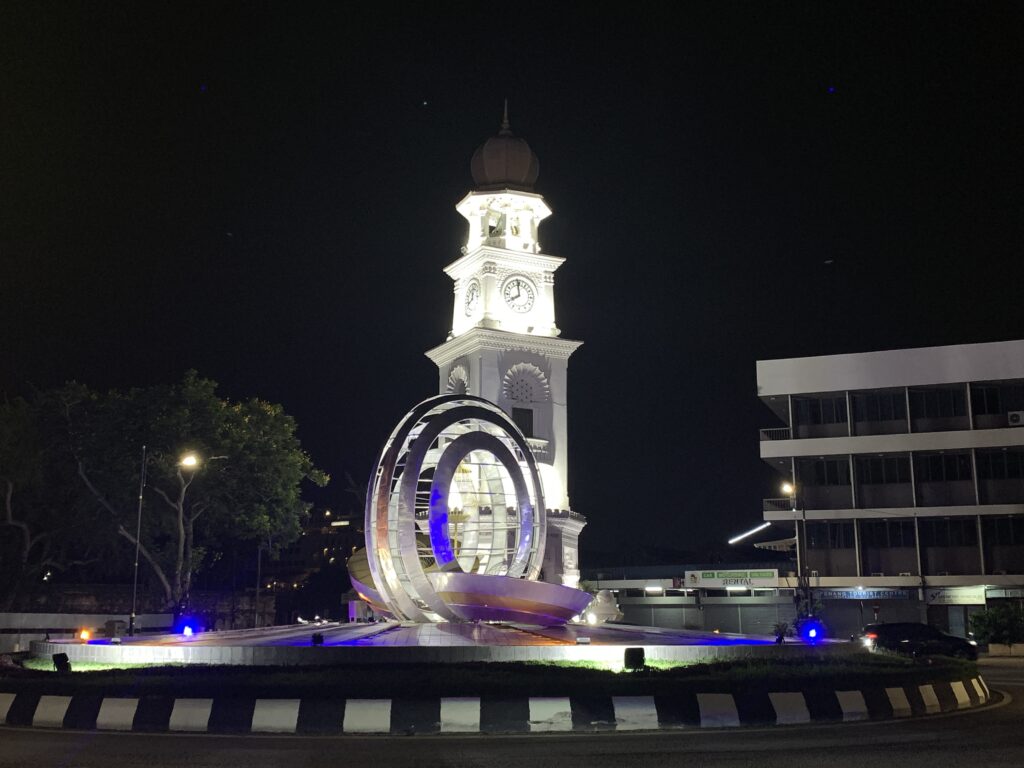
The Queen Victoria Memorial Clock Tower stands as a cherished icon of George Town, Penang, drawing locals and tourists alike. This colonial-era landmark reflects Penang’s vibrant history, blending its past as a British settlement with its multicultural heritage.
Situated at the junction of Beach Street and Light Street, this impressive structure is not just a clock tower; it symbolizes the island’s historic milestones and architectural grandeur. Recognized among prominent Penang tourist attractions, the tower serves as a gateway to explore the historic commercial and civic precincts of George Town.1
Table of Contents
The Origins: From Reservoir to Clock Tower
Long before the Queen Victoria Memorial Clock Tower became an iconic symbol of Penang, the site served a utilitarian but critical function in the early 19th century. In 1821, the area was home to a watering reservoir that played a pivotal role in the island’s maritime operations. Fed by an aqueduct system originating in the lush surroundings of what is now the Botanic Gardens2, this reservoir provided fresh water to ships docked in Penang’s bustling harbor.
The reservoir’s strategic location near the coastline made it a vital resource for maritime trade, ensuring that vessels departing from Penang had access to clean water for their voyages. Water was transported to ships via a simple timber jetty extending into the bay, underscoring the importance of the site in the island’s trade and logistics network during the colonial era.
The transformation of this functional site into a celebrated landmark began decades later. By the late 19th century, Penang was thriving as a hub of commerce and cultural exchange under British rule. The idea of creating a memorial structure emerged during the centennial celebrations of Penang’s founding in 1886. Although initial plans did not materialize, the vision of a significant monument persisted, culminating in the proposal for a memorial clock tower to honor Queen Victoria’s Diamond Jubilee in 1897.
This transition marked a shift in the site’s purpose—from serving as a crucial resource for seafarers to becoming a timeless landmark that represents the island’s rich colonial and cultural heritage. The choice of this location for the clock tower reflected its historical significance and its central role in Penang’s development, making it a fitting place for a monument that continues to stand as a testament to the island’s history and progress.
By linking the origins of the site to the construction of the Queen Victoria Memorial Clock Tower, this location symbolizes Penang’s evolution from a maritime outpost to a city renowned for its architectural heritage and vibrant cultural identity.
A Tribute to Queen Victoria’s Reign
The Queen Victoria Memorial Clock Tower stands as an enduring symbol of loyalty and respect for Queen Victoria, whose reign of 60 years marked an era of monumental change in the British Empire. The idea for the clock tower was conceived to commemorate her Diamond Jubilee, a milestone that celebrated her remarkable 60-year reign from 1837 to 1897. This architectural masterpiece not only honors the British monarch but also reflects the socio-political dynamics of Penang during the colonial period.
The project was made possible by Cheah Chen Eok, a well-known Chinese businessman and philanthropist in Penang. His contribution of $30,000 for the construction was a significant gesture of allegiance to the British Crown, symbolizing the strong ties between Penang’s Chinese community and the colonial government. Cheah’s stipulation that the tower be exactly 60 feet tall—one foot for each year of Queen Victoria’s reign—added a personal and symbolic touch to the project, emphasizing his attention to detail and his admiration for the Queen’s longevity on the throne.
During the colonial era, many members of the local Chinese elite, including Cheah Chen Eok, embraced British rule and even became naturalized British subjects. This allegiance was not merely symbolic but also reflected the mutual benefits of a stable colonial administration and opportunities for economic growth. The construction of the Queen Victoria Memorial Clock Tower thus served as a public demonstration of loyalty, reinforcing the Chinese community’s role as a vital and cooperative part of Penang’s colonial society.
What makes this tribute unique is the foresight and generosity of Cheah Chen Eok in funding the project, despite it being an era of economic challenges for some. His vision for a landmark that would not only celebrate a royal milestone but also stand as a testament to Penang’s thriving and multicultural society was both ambitious and inspiring. The tower’s completion in 1902, though it came 18 months after Queen Victoria’s death, was a poignant reminder of the lasting influence of her reign and the respect she commanded even in far-flung corners of the British Empire.
The Queen Victoria Memorial Clock Tower remains an architectural jewel in Penang, drawing visitors who marvel at its historical significance and the cultural stories it represents. Its towering presence and unique symbolism serve as a timeless tribute to one of history’s most iconic monarchs and to the individuals like Cheah Chen Eok who played a pivotal role in its realization.
The Design Competition and Challenges
In 1897, a design competition was announced to select the best architectural proposal for this prestigious project. To attract talented participants, the competition offered a first prize of $150 and a second prize of $50—significant sums at the time. The initiative sparked widespread interest, and submissions showcased a variety of architectural styles, reflecting the diversity and creativity of the era.
After two rounds of evaluations and several design modifications, the winning proposal was submitted by municipal engineer Mr. Peirce, whose design met the committee’s vision for a grand and enduring memorial. His ability to balance functionality and aesthetic appeal made his submission stand out. The competition’s runners-up included Swan & Maclaren, a firm that later became renowned for iconic colonial structures, and the Penang Foundry Company, which demonstrated the local expertise in engineering and architecture.
Construction began in 1900 under the experienced supervision of the engineering and architectural firm Barnett and Stark, which had a strong reputation for managing complex projects in colonial Malaya. Local contractors and materials were employed, showcasing the capabilities of Penang’s skilled workforce and ensuring that the tower would reflect the region’s craftsmanship. However, like many ambitious projects of the time, the clock tower faced unexpected financial challenges.
Although Cheah Chen Eok, the project’s primary benefactor, had initially pledged $30,000 to fund the construction, escalating costs during the construction phase required him to contribute an additional $5,0003. These rising expenses were attributed to the intricate architectural details and the high-quality imported materials, such as the European clock mechanisms and opal glass for the clock faces. Despite these challenges, Cheah remained committed to completing the project, demonstrating his dedication to creating a landmark that would honor Queen Victoria’s Diamond Jubilee and symbolize Penang’s colonial heritage.
The challenges extended beyond finances. Supervising construction in the early 20th century presented logistical hurdles, including sourcing materials, coordinating workers, and managing timelines in an era without modern communication tools. The meticulous design also required precision in assembly, particularly for the clock mechanisms and the 97-foot structure’s intricate decorative elements.
Ultimately, these obstacles were overcome, and the Queen Victoria Memorial Clock Tower was completed in 1902. The perseverance of everyone involved—from the designers and engineers to the laborers and benefactors—ensured the successful realization of a structure that continues to captivate visitors to this day. The clock tower is not just an architectural achievement but a testament to the collective effort and determination required to bring such an ambitious vision to life.
Unique Architectural Features
The tower were completed in 1902, stands as a remarkable example of architectural ingenuity, blending elements of colonial and Moorish design into a cohesive and visually striking monument. Its design reflects both functionality and grandeur, capturing the spirit of Penang’s multicultural heritage and colonial history.
Rising 60 feet to the center of the clocks and extending to 97 feet at the tip of its domed cupola, the structure was carefully proportioned to symbolize Queen Victoria’s 60-year reign. This attention to detail not only makes it a fitting tribute but also showcases the artistry and precision of early 20th-century engineering. The European-imported clocks feature opal glass windows that were originally illuminated at night using acetylene lighting, a cutting-edge technology at the time. This ensured that the tower remained a beacon of both time and elegance, even after dark.
One of the most captivating features of the clock tower is its belfry, which housed five bells. These bells were meticulously tuned to chime the Westminster quarters, a melody synonymous with some of the world’s most iconic clock towers, such as Big Ben in London. The hour bell, weighing an impressive one ton, added a deep and resonant tone that could be heard across George Town. These features elevated the tower from a mere timepiece to an elegant civic statement, symbolizing order, progress, and unity within the community.
The intricate Moorish-inspired arches and detailed carvings on the facade are a testament to the craftsmanship of the local builders who worked under the supervision of the architectural firm Barnett and Stark. These details reflect the global influences that shaped Penang’s cultural identity, with the design seamlessly blending Eastern and Western architectural traditions.
The clock tower’s foundation and structure were constructed using durable local materials, chosen for their ability to withstand Penang’s tropical climate. Its durability has allowed the tower to stand for over a century, weathering not only the passage of time but also the challenges of war and environmental conditions.
The decorative elements of the tower, including the domed cupola and ornate detailing, were designed to draw the eye upward, creating a sense of awe and reverence. The use of symmetry and proportion adds to its visual appeal, making it a masterpiece of architectural harmony. These features ensured that the Queen Victoria Memorial Clock Tower would become a landmark synonymous with Penang’s rich heritage and enduring beauty.
Today, visitors continue to marvel at the unique architectural features of this historic clock tower. It remains a source of pride for Penang’s residents and a must-see attraction for those who wish to experience the island’s vibrant past through its timeless monuments.
Leaning Icon of George Town
One of its most distinguishing features is its slight tilt, a result of the turbulence of World War II. This lean has become a defining characteristic, turning the clock tower into a symbol of survival amidst destruction.
In December 1941, the tranquility of Penang was shattered as Japanese forces launched devastating air raids. The clock tower, situated in a strategic area near George Town’s bustling center, was among the structures impacted by the bombings. The force of the explosions caused the foundation to shift slightly, leading to its now-famous lean. The damage did not end there where in 19454, as the Allies carried out bombings to liberate Penang from Japanese occupation, the tower endured further stress.
Despite the structural compromise, the clock tower remained standing, a silent witness to the chaos of war and the resilience of Penang’s people. After the war, efforts were made to repair the damage. Local craftsmen and engineers worked diligently to restore the clock mechanism and its chiming feature, which had been disrupted during the conflict. By the late 1940s, the chimes once again rang out across George Town, marking the hours and symbolizing a return to normalcy for the city’s residents.
Interestingly, the lean of the Queen Victoria Memorial Clock Tower has added to its allure over time. Visitors are often drawn to this unique feature, which distinguishes it from other historical landmarks in Penang. The tilt is a poignant reminder of the tower’s endurance through one of the most challenging periods in history, connecting it not only to colonial heritage but also to the wartime struggles faced by Penang.
Beyond its structural significance, the leaning clock tower serves as a metaphor for the resilience and adaptability of George Town itself. Much like the city, the tower has weathered change, conflict, and time, emerging as a testament to the enduring spirit of the community.
The tower now stands as a cherished landmark and an essential stop for history enthusiasts visiting Penang. Its tilt, rather than being seen as a flaw, has become a celebrated feature, embodying the spirit of perseverance and the layers of history that make George Town a UNESCO World Heritage Site. For locals and tourists alike, the leaning tower serves as a timeless reminder of the past while continuing to mark the passage of time for a city that never ceases to evolve.
The Legacy of Cheah Chen Eok
Born in 1852, Cheah grew up in a rapidly modernizing Penang and was among the first to benefit from a formal education at the esteemed Penang Free School, which laid the foundation for his future successes.
Cheah’s career began modestly, but his ambition and business acumen quickly set him apart. He became a prominent merchant and established himself as one of the leading businessmen in Penang. His ventures spanned lucrative industries such as tin mining, opium monopolies, and spirit licensing, all of which were integral to the colonial economy of the time. In addition to these, he invested in various local enterprises, solidifying his status as one of the wealthiest individuals in Penang.5
While Cheah was undoubtedly a shrewd businessman, his legacy is defined by his dedication to the betterment of the community. His philanthropy extended beyond financial contributions; it encompassed a vision of Penang as a thriving, harmonious society. His funding of the Queen Victoria Memorial Clock Tower, a project he contributed over $35,000 to, demonstrated his loyalty to the British Crown and his belief in strengthening Penang’s civic and cultural identity.
Cheah’s philanthropic spirit was not confined to the clock tower. He played an active role in numerous initiatives that benefitted Penang’s residents, irrespective of their ethnic or social background. His efforts in community development included contributions to local education, infrastructure, and cultural preservation. Cheah’s involvement as a Justice of the Peace and a Municipal Commissioner further reflected his commitment to fostering progress and unity within the city.
Through his philanthropic projects, Cheah Chen Eok left an indelible mark on George Town heritage. His vision extended beyond personal success, focusing on creating landmarks and systems that would enrich the lives of future generations. The Queen Victoria Memorial Clock Tower stands as a testament to his dedication to the community and his ability to turn grand ideas into enduring realities.
Cheah’s contributions also highlight the complex relationship between Penang’s local elite and the colonial administration. His decision to fund the clock tower not only celebrated Queen Victoria’s Diamond Jubilee but also reinforced the collaborative spirit that defined Penang’s multicultural society during the colonial period.
Even today, the legacy of Cheah Chen Eok is woven into the fabric of Penang’s history. As visitors admire the Queen Victoria Memorial Clock Tower, they are reminded of a man whose vision and generosity helped shape Penang into the vibrant cultural and economic hub it is today. His story is a compelling narrative of ambition, generosity, and the enduring impact one individual can have on their community.
Why the Queen Victoria Memorial Clock Tower is More Than Just a Landmark?
- Cultural Symbol: The clock tower reflects Penang’s colonial past while showcasing the loyalty and ingenuity of its local community.
- Architectural Excellence: Its design and construction highlight Penang’s blend of local craftsmanship and British architectural influence.
- Tourist Attraction: As a part of George Town’s UNESCO Heritage Site, it draws visitors worldwide, enriching Penang’s tourism industry.
- Historical Insight: Learning about the clock tower provides valuable context for understanding Penang’s development over two centuries.
Final Thoughts
The Queen Victoria Memorial Clock Tower is more than a historic landmark; it is a symbol of Penang’s resilience, heritage, and multicultural spirit. Its architectural elegance, storied past, and cultural significance make it a must-visit destination for anyone exploring George Town’s heritage sites.
Whether you’re a history enthusiast, a curious traveler, or a local resident, the clock tower invites you to step back in time and appreciate the narratives that have shaped Penang. As a timeless gem, it continues to inspire awe and admiration, preserving the legacy of Queen Victoria and the visionary benefactors who brought it to life.
Remarkable Journey Through Time The Story of Queen Victoria Memorial Clock Tower
1821 – From Reservoir to Resource
- The site of the future clock tower begins as a watering reservoir, providing essential water supplies to ships via an aqueduct from the Botanic Gardens.
1886 – Abandoned Centennial Plan
- Plans emerge to build a clock tower commemorating Penang’s centennial settlement by the East India Company.
- The project is abandoned despite funding offers from local businessman Koh Seang Tat.
1897 – A Vision for Queen Victoria’s Jubilee
- In celebration of Queen Victoria’s Diamond Jubilee, Cheah Chen Eok, a prominent Chinese philanthropist, pledges $30,000 for a memorial clock tower.
1898 – Designing History
- A design competition concludes after two rounds.
- Municipal engineer Mr. Peirce’s proposal is selected as the final design.
1900 – Construction Takes Shape
- Construction begins under the supervision of the Barnett and Stark firm, using local contractors and materials.
- Rising costs prompt Cheah Chen Eok to contribute an additional $5,000.
1902 – A Monument is Completed
- The Queen Victoria Memorial Clock Tower is officially completed on July 23.
- The tower stands 60 feet tall with intricate colonial and Moorish architectural elements.
- The project is completed 18 months after Queen Victoria’s death.
1941 – Wartime Damage Begins
- The tower sustains damage during Japanese bombings in World War II.
- This results in the tower’s now-famous tilt.
1945 – More Bombing Destruction
- Further damage occurs during allied bombings.
- Repairs in the post-war era restore the clock and chimes to working order.
1970s–1990s – A Heritage Landmark Emerges
- The tower continues to serve as a public timepiece.
- It becomes an increasingly significant tourist landmark as Penang embraces its colonial heritage.
2008 – Recognition as a UNESCO Gem
- George Town is designated a UNESCO World Heritage Site.
- The clock tower’s status as a key symbol of George Town heritage is solidified.
Present Day – Timeless Tourist Attraction
- The Queen Victoria Memorial Clock Tower stands as one of the most visited Penang tourist attractions.
- It is admired for its architectural beauty and rich history.
FAQ
What are the visiting hours ?
It is accessible to visitors 24/7 as it is an open public landmark. However, the best time to visit is during daylight hours for better visibility and safety.
What is the best time to visit the clock tower?
The best time to visit is early morning or late afternoon, when the lighting is ideal for photography. Evening visits are also popular for admiring the tower under soft streetlights, especially during festive seasons.
Is there an entrance fee to visit?
No, visiting is completely free of charge as it is a public monument.
Nearby Attractions to Explore
The Queen Victoria Memorial Clock Tower serves as an excellent starting point for a historical exploration of George Town. Nearby attractions include:
Fort Cornwallis
Just a short walk away, Fort Cornwallis is the largest standing fort in Malaysia. It offers a glimpse into Penang’s colonial past with well-preserved cannons, a lighthouse, and an engaging historical exhibition.
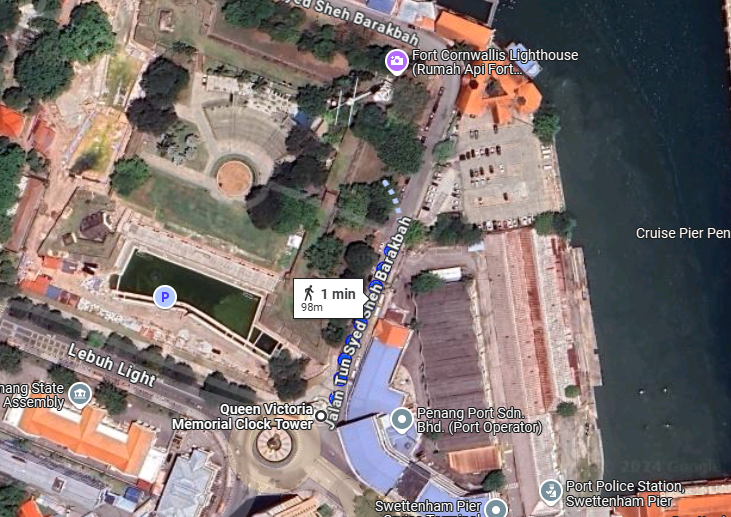
Pinang Peranakan Mansion
This beautifully restored mansion showcases the opulent lifestyle of the Peranakan Chinese community. It’s an architectural gem filled with antiques, artifacts, and cultural exhibits.
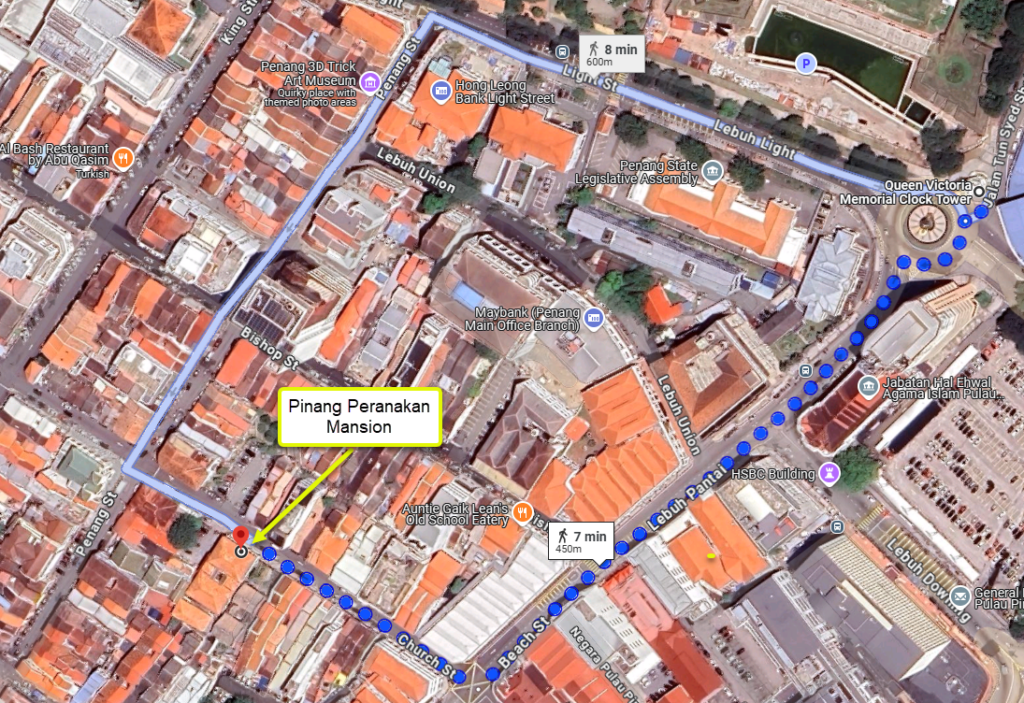
The Esplanade
A picturesque promenade overlooking the sea, the Esplanade is a popular spot for leisurely walks, cultural performances, and enjoying the vibrant atmosphere of George Town.
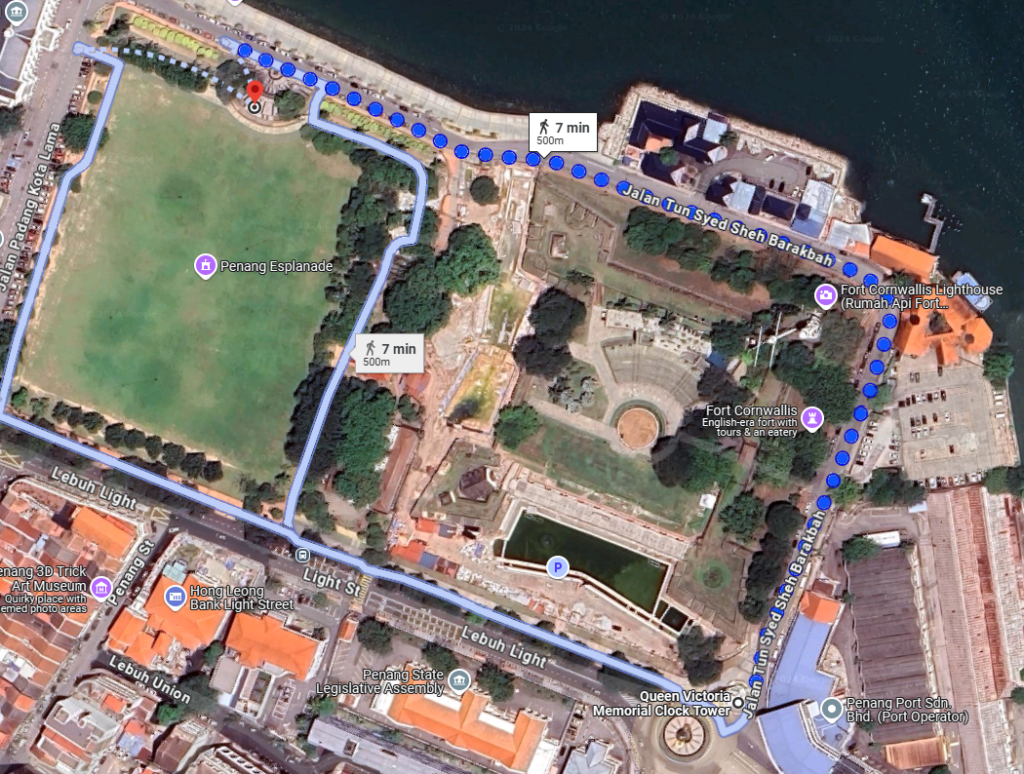
Penang State Museum and Art Gallery
A treasure trove of history and art, the museum provides insights into Penang’s multicultural heritage through fascinating exhibits and artworks.
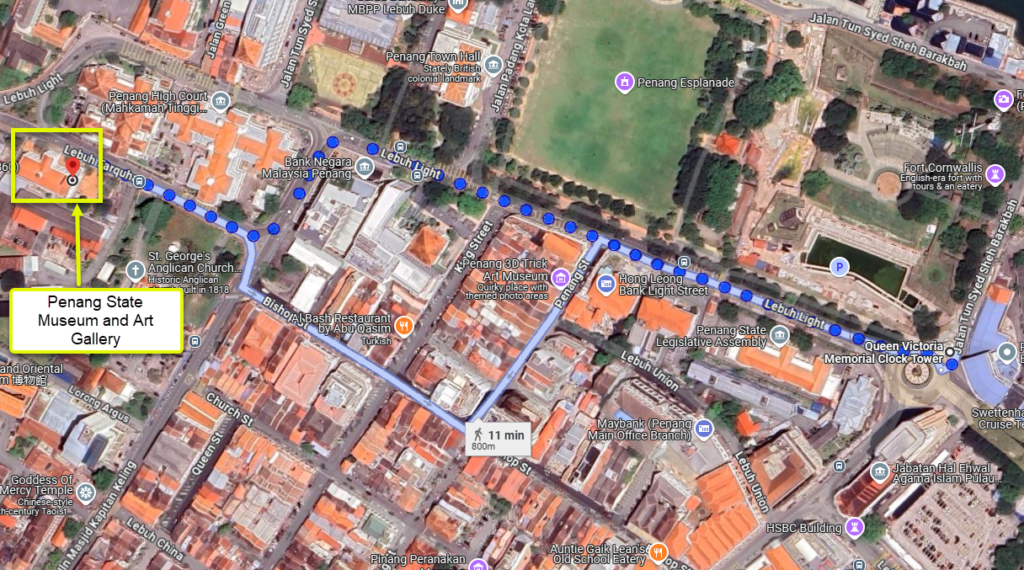
Weld Quay Clan Jetties
A unique waterfront settlement, the Clan Jetties offer a glimpse into the lives of Chinese immigrant families who still reside in these historic stilt houses.
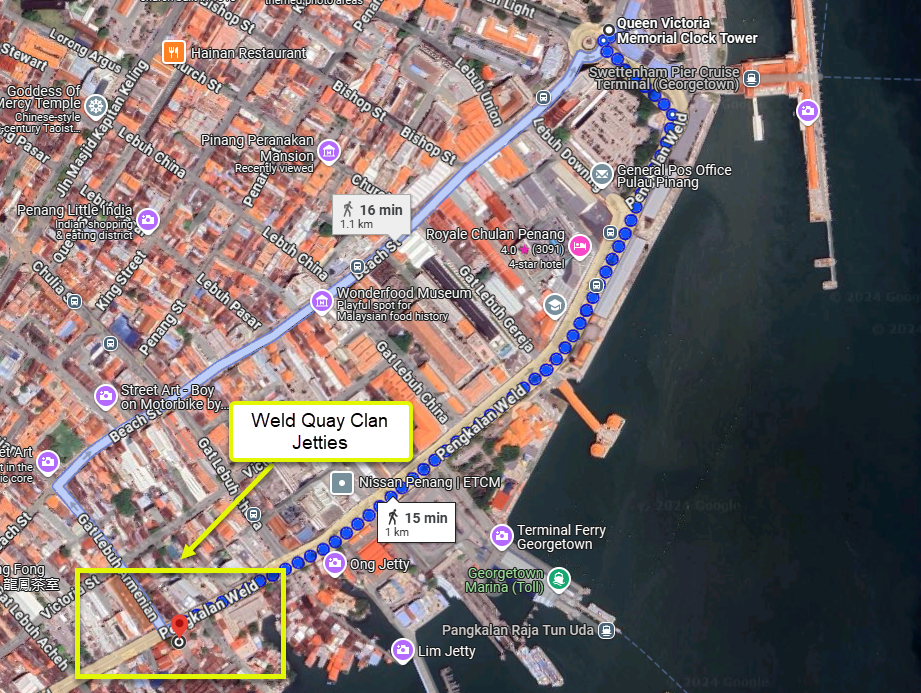
Little India
Experience the vibrant sights, sounds, and aromas of Little India, a lively neighborhood known for its traditional shops, street food, and cultural festivities.
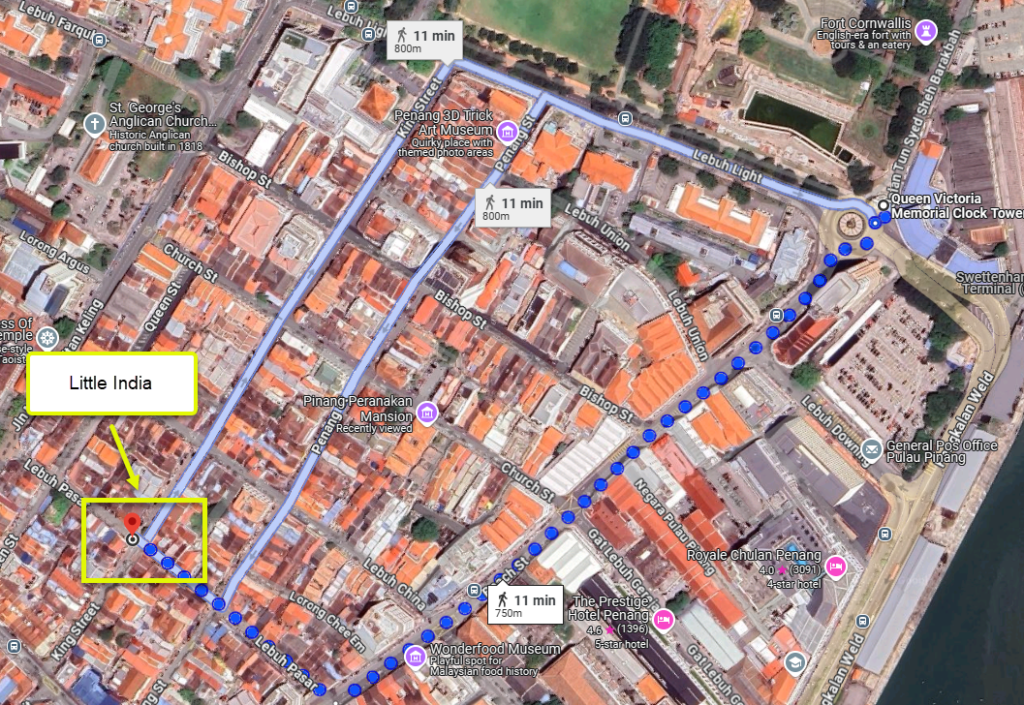
References
- “Jubilee Clock Tower”, Wikipedia, last edited 27th October 2024, wikipedia.org ↩︎
- Marcus Langdon, “Queen Victoria Memorial Clock Tower – Junction of Beach and Light Streets”, George Town’s Historic Commercial & Civil Precints, 2015 ↩︎
- Eugene Khoo, “Cheah Chen Eok”, Overseas Chinese in The British Empire, last edited 27th December 2011, overseaschineseinthebritishempire.blogspot.com ↩︎
- “Queen Victoria Memorial Clocktower”, Discover with Timothy, last edited 4th June 2005, penang-traveltips.com ↩︎
- “Life of opium magnate Cheah Chen Eok, donor of the Penang Jubilee Clock Tower”, Malaysia 1786 – 1957, last edited 11th May 2023, britishmalaya.home.blog ↩︎
